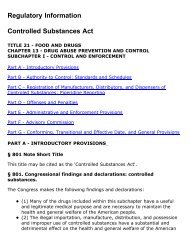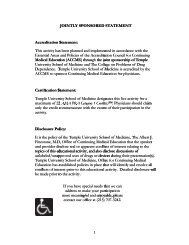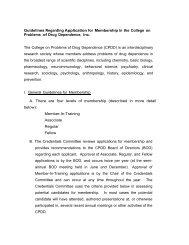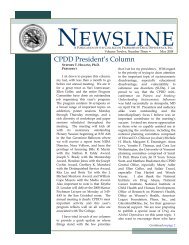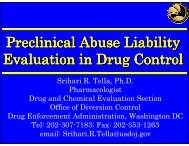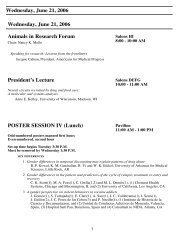CPDD 72nd Annual Meeting • Scottsdale, Arizona - The College on ...
CPDD 72nd Annual Meeting • Scottsdale, Arizona - The College on ...
CPDD 72nd Annual Meeting • Scottsdale, Arizona - The College on ...
Create successful ePaper yourself
Turn your PDF publications into a flip-book with our unique Google optimized e-Paper software.
77<br />
INTERNET-BASED POST-MARKETING SURVEILLANCE OF<br />
NEWLY MARKETED OPIOID ANALGESICS.<br />
John S Brownstein, E McNaught<strong>on</strong>, T A Cassidy, S H Budman, S F Butler;<br />
Inflexxi<strong>on</strong>, Inc., Newt<strong>on</strong>, MA<br />
Aims: <str<strong>on</strong>g>The</str<strong>on</strong>g> Nati<strong>on</strong>al Addicti<strong>on</strong>s Vigilance Interventi<strong>on</strong> & Preventi<strong>on</strong> PROgram<br />
(NAVIPPRO) post-marketing surveillance system m<strong>on</strong>itors a several data<br />
streams, including two, near real-time, Internet-based, product-specific datasets:<br />
(1) Web-Informed Services (WIS) m<strong>on</strong>itors Internet prescripti<strong>on</strong> drug abuse<br />
chatter <strong>on</strong> abuse related websites, and (2) Geotemporal Real-time Internet-based<br />
Intelligence for Drugs (Media-GRIID) tracks abuse-related media reports<br />
over 20,000 news outlets. How these data streams may anticipate abuse rates as<br />
new prescripti<strong>on</strong> opioid products increase market share is not well understood.<br />
Methods: We examined the relati<strong>on</strong>ship of these Internet-based data streams to<br />
abuse as measured by NAVIPPRO’s ASI-MV® C<strong>on</strong>nect which collects abuse<br />
data in the past 30 days from clients in treatment at a network of more than 530<br />
addicti<strong>on</strong> treatment facilities across the US. Data for two opioid products,<br />
Opana® ER and EMBEDA, are examined from product-launch to explore<br />
how Internet chatter and media reports may anticipate abuse rates. Time series<br />
analyses were c<strong>on</strong>ducted for the respective life-span of each product (Opana®:<br />
July 2006-present; EMBEDA: August 2009-present). Cross correlati<strong>on</strong>s compared<br />
each data stream adjusting for time lags between the data sources and the<br />
ASI-MV® C<strong>on</strong>nect measure of prescripti<strong>on</strong> opioid abuse.<br />
Results: Significant correlati<strong>on</strong>s over time were observed for both Internet-based<br />
data streams and ASI-MV® abuse rates adjusting for various time lags. Analyses<br />
identified optimal time lags of 7 m<strong>on</strong>ths for WISTM prescripti<strong>on</strong> opioid web<br />
chatter (R2=0.73) and 11 m<strong>on</strong>ths for Media-GRIID prescripti<strong>on</strong> opioid-related<br />
media menti<strong>on</strong>s (R2=0.38).<br />
C<strong>on</strong>clusi<strong>on</strong>s: <str<strong>on</strong>g>The</str<strong>on</strong>g>se preliminary results raise the possibility that Internet-based<br />
data may provide early situati<strong>on</strong> awareness intelligence with respect to abuse levels<br />
of analgesic products as market share increases. <str<strong>on</strong>g>The</str<strong>on</strong>g>se data may serve as leading<br />
indicators of trends observed in the clinical setting. Implicati<strong>on</strong>s and robustness<br />
of these observati<strong>on</strong>s are discussed with respect to Opana® ER and<br />
EMBEDA.<br />
Financial Support: Inflexxi<strong>on</strong>, Inc.<br />
79<br />
HOW ACCURATE ARE ESTIMATES OF COMMUNITY ABUSE<br />
MADE BY LOCAL KEY INFORMANTS?<br />
Sim<strong>on</strong> H Budman, T A Cassidy, K Lioy, S F Butler; Inflexxi<strong>on</strong>, Inc., Newt<strong>on</strong>, MA<br />
Aims: Post-marketing surveillance of prescripti<strong>on</strong> medicati<strong>on</strong>s often uses key<br />
informants as a primary source to estimate local abuse rates. We examined how<br />
key informant report corresp<strong>on</strong>ds to direct self-report of clients entering substance<br />
abuse treatment using data from the ASI-MV® C<strong>on</strong>nect, a NAVIP-<br />
PRO(TM) data stream, which collects data from a nati<strong>on</strong>al network of treatment<br />
facilities.<br />
Methods: Treatment facilities having relatively high and low rates of prescripti<strong>on</strong><br />
opioid abuse were identified. Counselors at these treatment centers served as<br />
local key informants and estimated rates of abuse at their treatment center and<br />
in their community <strong>on</strong> an Internet survey.<br />
Results: Significant differences in the expected directi<strong>on</strong> were obtained for estimates<br />
of abuse rates by counselors from high- and low-rate facilities for<br />
OxyC<strong>on</strong>tin® (p



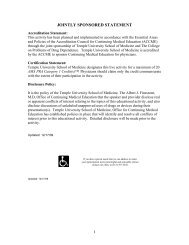
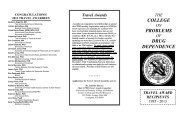
![2013SYMP AND WORKSHOP LIST[web]](https://img.yumpu.com/35325424/1/190x245/2013symp-and-workshop-listweb.jpg?quality=85)
